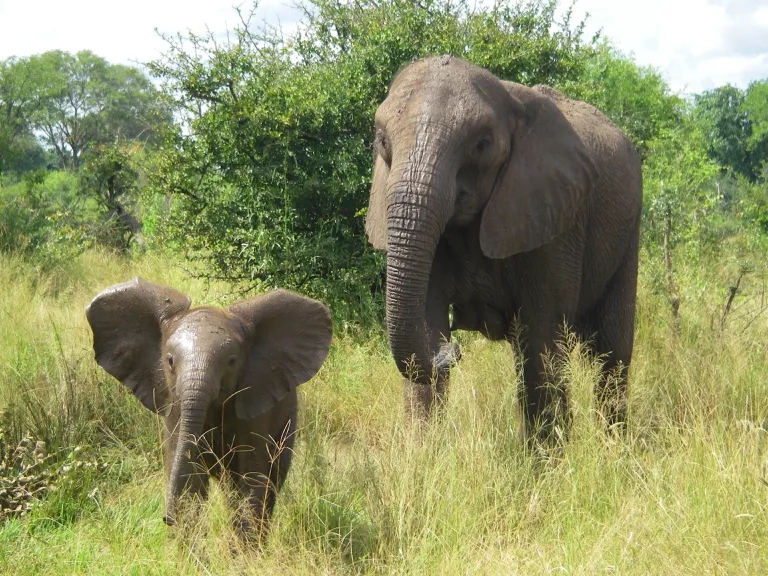为什么大象会受到威胁
为什么大象会受到威胁
There are two main groups of elephants left on Earth: African elephants and Asian elephants. Both face serious threats to their long-term survival, although the risks vary widely from place to place. Scientists classify all Asian elephants as a single species, and while the same is often done with African elephants, genetic evidence suggests Africa really has two separate species: savanna elephants and forest elephants.
地球上的大象主要有两种:非洲象和亚洲象。它们的长期生存都面临严重威胁,尽管各地的风险差别很大。科学家们把所有的亚洲象都归为一个物种,而非洲象也经常被归为一个物种,基因证据表明非洲确实有两个不同的物种:草原象和森林象。

African elephants are less endangered than their counterparts in Asia, but both face serious risks.Michelle Gadd [public domain]/USFWS/Flickr
Asian elephants are endangered, according to the International Union for Conservation of Nature (IUCN), which lists African elephants as vulnerable. Several million African elephants roamed across the continent as recently as the early 20th century, but today only about 350,000 remain. Asian elephants were less abundant to begin with, reportedly numbering about 200,000 a century ago, giving them even less of a buffer against population declines. There are now fewer than 40,000 Asian elephants left in the wild, raising the specter of extinction unless something can be done to save them.
根据国际自然保护联盟(IUCN)的说法,亚洲象已经濒临灭绝,非洲象也被列为易受攻击的物种。就在20世纪初,数百万头非洲象还在非洲大陆上游荡,但如今只剩下35万头。一开始亚洲象的数量就比较少,据报道,一个世纪前亚洲象的数量大约为20万只,这使得亚洲象对其数量下降的缓冲余地更小。目前野生亚洲象不足四万头,如果不采取措施拯救它们,就会引发灭绝的恐慌。
Threats to Elephants
大象面临的威胁
The main threat to both Asian and African elephants is a familiar one for wildlife around the world: loss and fragmentation of their habitat. Many elephants also face additional dangers, though, including both direct and indirect conflict with people.
亚洲和非洲象面临的主要威胁与世界各地的野生动物一样:栖息地的丧失和破碎。许多大象还面临着额外的危险,包括与人类的直接和间接冲突。
Habitat Loss and Fragmentation
栖息地丧失和破碎化
Humans are encroaching on elephants in Africa as well as Asia, but the pressure is especially severe for Asian elephants. Their habitats are increasingly shrunken and fragmented by agriculture, logging, roads, and development for residential or commercial use. Elephants are migratory animals who depend on large, contiguous territories, and this trend robs them of vital resources like food and water. It can also limit genetic diversity by isolating populations from each other.
人类正在蚕食非洲和亚洲大象的栖息地,但对亚洲象来说,压力尤其严重。由于农业、伐木、道路和住宅或商业用途的开发,它们的栖息地日益缩小和破碎。大象是一种迁徙动物,它们依赖于大片的、毗邻的领地,这种趋势剥夺了它们的食物和水等重要资源。它还可以通过隔离种群来限制遗传多样性。
Conflict With Humans
与人类的冲突
On top of occupying and altering elephant habitats, people also commonly plant food crops there. As more farms appear in forests and savannas where elephants are accustomed to roaming, their crops often become easy targets for hungry elephants. A herd can destroy a year’s harvest in one night, leading to understandable animosity among farmers, many of whom are nutritionally vulnerable and have little income to offset the loss. This sometimes leads to retaliatory killings of elephants, interactions that are dangerous for everyone involved. These clashes lead to hundreds of deaths across Asia and Africa every year, both elephant and human.
除了占领和改变大象的栖息地,人们还经常在那里种植粮食作物。随着越来越多的农场出现在大象习惯于漫游的森林和热带稀树大草原上,这些农场的庄稼往往很容易成为饥饿的大象的目标。一群牛可以在一夜之间毁掉一年的收成,这在农民中引发了可以理解的敌意,他们中的许多人营养不良,又没有多少收入来弥补损失。这有时会导致对大象的报复性杀戮,这种互动对参与其中的每个人都是危险的。这些冲突导致亚洲和非洲每年有数百人死亡,包括大象和人类。
Climate Crisis
气候危机
All elephants need lots of water, a thirst that drives much of their migratory behavior and daily activities. The need for water can already be a big challenge for elephants even under normal circumstances, but as the climate crisis fuels longer, drier droughts in many places, it can become all but impossible to find enough. This threat is also compounded as their habitats shrink and splinter, since thirsty elephants now have even fewer options for undeveloped places to find water.
所有的大象都需要大量的水,这种口渴驱使着它们的大部分迁徙行为和日常活动。即使在正常情况下,对水的需求对大象来说也已经是一个巨大的挑战,但随着气候危机在许多地方加剧了更持久、更干燥的干旱,要找到足够的水几乎是不可能的。这种威胁还因为它们的栖息地缩小和破碎而加剧,因为口渴的大象现在在未开发的地方寻找水源的选择更少了。
Poaching
偷猎
Many elephant populations plummeted last century due to unsustainable hunting, largely fueled by demand for their ivory tusks. And while the Convention on International Trade in Endangered Species (CITES) banned the international trade of ivory in 1989, legal ivory markets have remained in some countries, enabled by a resurgent black market and well-armed gangs of poachers. Poaching can threaten elephants almost anywhere, but most illegal ivory currently comes from African elephants, according to the World Wildlife Fund (WWF), where thousands of elephants are killed by poachers every year.
上个世纪,由于对象牙的需求,不可持续的捕猎导致许多大象的数量急剧下降。尽管《濒危物种国际贸易公约》在1989年禁止了国际象牙贸易,但在一些国家,由于黑市的复苏和武装精良的盗猎团伙,合法的象牙市场依然存在。偷猎几乎可以威胁到任何地方的大象,但根据世界野生动物基金会的数据,目前大多数非法象牙来自非洲大象,每年有数千头大象被偷猎者杀死。
What Can We Do to Help?
我们能帮上什么忙?
1.Protect Their Habitat
保护它们的栖息地
2.Reduce Demand for Ivory
减少象牙需求
3.Help Humans Who Share Their Habitat
帮助分享栖息地的人类


















